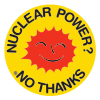
| Anti-nuclear movement |
|---|
 |
| By country |
| Lists |
Long one of the world's most committed promoters of civilian nuclear power, Japan's nuclear industry was not hit as hard by the effects of the 1979 Three Mile Island accident (USA) or the 1986 Chernobyl disaster (USSR) as some other countries. Construction of new plants continued to be strong through the 1980s and into the 1990s. However, starting in the mid-1990s there were several nuclear related accidents and cover-ups in Japan that eroded public perception of the industry, resulting in protests and resistance to new plants. These accidents included the Tokaimura nuclear accident, the Mihama steam explosion, cover-ups after accidents at the Monju reactor, and the 21 month shut down of the Kashiwazaki-Kariwa Nuclear Power Plant following an earthquake in 2007. Because of these events, Japan's nuclear industry has been scrutinized by the general public of the country.[3]
The negative impact of the 2011 Fukushima Daiichi nuclear disaster has changed attitudes in Japan. Political and energy experts describe "nothing short of a nationwide loss of faith, not only in Japan's once-vaunted nuclear technology but also in the government, which many blame for allowing the accident to happen".[4] Sixty thousand people marched in central Tokyo on 19 September 2011, chanting "Sayōnara nuclear power" and waving banners, to call on Japan's government to abandon nuclear power, following the Fukushima disaster.[1][2] Bishop of Osaka, Michael Goro Matsuura, has called on the solidarity of Christians worldwide to support this anti-nuclear campaign.[5] In July 2012, 75,000 people gathered near in Tokyo for the capital's largest anti-nuclear event yet. Organizers and participants said such demonstrations signal a fundamental change in attitudes in a nation where relatively few have been willing to engage in political protests since the 1960s.[6]
Anti-nuclear groups include the Citizens' Nuclear Information Center, Stop Rokkasho, Hidankyo, Sayonara Nuclear Power Plants, Women from Fukushima Against Nukes, and the Article 9 group. People associated with the anti-nuclear movement include: Jinzaburo Takagi, Haruki Murakami, Kenzaburō Ōe, Nobuto Hosaka, Mizuho Fukushima, Ryuichi Sakamoto and Tetsunari Iida.
As of September 2012, most Japanese people support the zero option on nuclear power, and Prime Minister Yoshihiko and the Japanese government announced a dramatic change of direction in energy policy, promising to make the country nuclear-free by the 2030s. There will be no new construction of nuclear power plants, a 40-year lifetime limit on existing nuclear plants, and any further nuclear plant restarts will need to meet tough safety standards of the new independent regulatory authority. The new approach to meeting energy needs will also involve investing $500 billion over 20 years to commercialize the use of renewable energy sources such as wind power and solar power.[7]
Former Prime Minister Shinzō Abe, who was elected in 2012, has put nuclear energy back on the political agenda, with plans to restart as many reactors as possible. In July 2015, the government submitted its ideas for reducing greenhouse gas emissions to the United Nations, and the proposal included a target for nuclear power to meet at least 20% of Japan's electricity consumption by 2030. Renewable energy sources, such as hydropower but also solar power, would contribute 22% or more. On 11 August 2015, the Sendai Nuclear Power Plant broke a four-year lull when it restarted one of its reactors. The restart is the first since Japan's nuclear power industry collapsed, following the 2011 Fukushima Daiichi disaster.[8]
As of March 10, 2020, out of Japan's 56 nuclear reactors, 24 are due to be decommissioned, 9 are currently working and 7 are ready to be restarted. 3 new reactors are under construction, in order to meet Japan's Fifth Energy Basic Plan (20%–22% nuclear energy by 2030).[9]
- ^ a b "Thousands march against nuclear power in Tokyo". USA Today. September 2011.
- ^ a b Cite error: The named reference
womprowas invoked but never defined (see the help page). - ^ "Japan cancels nuclear plant". BBC News. February 22, 2000.
- ^ Martin Fackler (March 8, 2012). "Japan's Nuclear Energy Industry Nears Shutdown, at Least for Now". The New York Times.
- ^ Sean McDonagh (March 6, 2012). "After Fukushima, Vatican joins growing army of opponents of nuclear power". The Irish Times. Archived from the original on November 17, 2018. Retrieved February 20, 2020.
- ^ Mure Dickie (July 17, 2012). "Japanese anti-nuclear demonstrations grow". The Washington Post.
- ^ Carol J. Williams (September 14, 2012). "In wake of Fukushima disaster, Japan to end nuclear power by 2030s". LA Times.
- ^ Davide Castelvecchi, "Japan's nuclear revival won't lower carbon emissions enough", Nature, 11 August 2015.
- ^ "Japan's Nuclear Power Plants". Nippon.com. Retrieved 16 April 2020.
